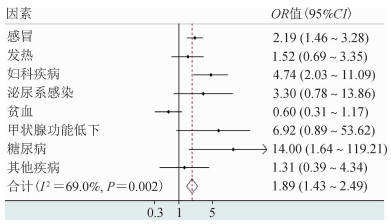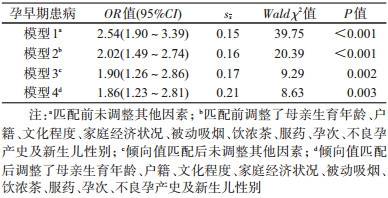文章信息
- 李敏敏, 张彬艳, 石国帅, 虢海月, 李姗姗, 武文韬, 米白冰, 党少农, 颜虹.
- Li Minmin, Zhang Binyan, Shi Guoshuai, Guo Haiyue, Li Shanshan, Wu Wentao, Mi Baibing, Dang Shaonong, Yan Hong.
- 育龄妇女孕早期患病与新生儿先天性心脏病的关联
- Association between congenital heart disease and maternal disease in early pregnancy in women of childbearing age
- 中华流行病学杂志, 2019, 40(9): 1130-1133
- Chinese Journal of Epidemiology, 2019, 40(9): 1130-1133
- http://dx.doi.org/10.3760/cma.j.issn.0254-6450.2019.09.021
-
文章历史
收稿日期: 2019-03-11
先天性心脏病(congenital heart disease)是最常见的出生缺陷,根据WHO的统计资料显示,全球每年出生的围产儿中患先天性心脏病的有150万,已成为婴儿出生后第一年死亡的主要原因[1-3]。据统计,我国新生儿先天性心脏病发病率约为0.6%~0.8%,这意味着每年新增先天性心脏病患儿15万~20万,其中大约有40%的先天性心脏病患儿因流产、死胎、死产、新生儿死亡以及得不到及时救治而夭折。先天性心脏病不仅对患儿的健康影响巨大,同时也给患儿的家庭及社会带来沉重的经济负担[4-7]。大量研究表明,母亲在怀孕期间出现的发热、感冒等疾病均会对胎儿的发育产生影响,尤其是胎儿心脏发育关键的孕早期容易引发心脏畸形[8-13]。本研究选择陕西省作为研究现场,通过横断面调查,分析母亲孕早期患病与新生儿先天性心脏病的关联。
资料与方法1.资料来源:来源于“陕西省出生缺陷现况及危险因素调查”的横断面调查。该调查于2013年7-12月在陕西省开展,采用多阶段分层随机整群抽样的方法,第一步:根据城乡比例,同时考虑人口密集度和生育水平,于陕西省随机抽10个城区和20个县。第二步:从抽样县和城区中分别随机抽取6个乡和3个街道办事处。第三步:从每个抽样乡和街道中分别随机抽取6个村和6个社区。第四步:在每个抽样村和社区中分别随机调查30名和60名符合条件的育龄妇女。纳入标准见文献[14],最终将有完整资料的28 680对母婴纳入分析。育龄妇女均在调查前签署知情同意书。
2.研究方法:在预调查的基础上采用统一标准方式按自行设计的“陕西省出生缺陷家庭调查问卷”,由经统一培训的西安交通大学公共卫生学院硕士研究生及本科生为调查员,采用面对面问卷调查的方式,收集母亲基本的社会人口学资料、既往生育史、围孕期生活方式、生活环境、患病情况、服药及营养素补充情况等;同时收集新生儿出生结局的基本信息,并予以核实。本研究分析育龄妇女孕早期患病与新生儿先天性心脏病之间的关系。
3.研究指标及定义:①先天性心脏病:按照国际疾病分类法(ICD-10编号Q00~Q99)分类。若胎(婴)儿为先天性心脏病患儿,则在调查表中准确记录具体的类型、部位、诊断依据及细节描述。母亲孕早期患病指孕1~3个月出现过感冒(流感、普通感冒或感冒样症状等)[15-16]、发热(>38 ℃)、妇科疾病(生殖系统感染,包括阴道炎、附件炎、宫颈炎、真菌感染等)、泌尿系感染、贫血、甲状腺功能低下、糖尿病等其他疾病。本研究还纳入母亲生育年龄、户籍所在地、文化程度、家庭经济状况、被动吸烟、饮茶、服药、孕次、不良孕产史、新生儿性别10个协变量。家庭经济状况按照家庭年总收入的P25、P75划分为贫穷(<P25)、中等(P25~P75)和富裕(>P75)3个等级。被动吸烟是指母亲孕早期每周至少有一次被动吸入烟雾并超过15 min。饮浓茶是指孕妇在孕早期至少饮一次浓茶。孕期服药是指孕早期服用过抗生素类、抗抑郁类、水杨酸类、兴奋剂类、镇咳类等药物。不良孕产史指母亲在最近一次妊娠之前发生过流产(药物流产和人工流产)、引产、死胎、死产、早产、生育出生缺陷儿、异位妊娠等异常生育情况。
4.质量控制:所有调查员均经过统一培训并且考核通过。调查表实行三级审核,即调查员现场审核、调查员当晚对当天调查表进行交换检查以及负责人对调查表内容进行最终审核,如发现疑问需返回重访。
5.统计学分析:采用EpiData 3.1软件进行数据双录入和逻辑纠错。采用Stata 14.0软件进行统计学分析,对资料进行一般性描述和假设检验,计数资料的描述采用例数和百分比(%),组间比较采用χ2检验或Fisher确切概率法。孕早期患病与新生儿先天性心脏病的关联分析采用logistic回归分析。倾向值是指一系列可观察到的协变量条件下,任意一个研究对象被分配到暴露组或者对照组的概率。本研究通过构建倾向值来进行混杂因素的控制,按最近匹配法1:1配对,卡钳值为0.000 1,匹配变量包括上述10个协变量[17-18]。最邻近匹配是指暴露组从第一个个体开始,在对照组中寻找倾向值与其最接近的个体,直到暴露组所有个体都有匹配的个体。最后以母亲孕早期患病和新生儿是否患先天性心脏病分别作为自变量和因变量,通过逐步校正混杂因素共建立4个logistic回归模型:模型1为未调整其他因素模型,模型2为调整了上述10个协变量模型,模型3为样本进行倾向值匹配后未调整其他因素模型,模型4为倾向值匹配后调整了上述10个协变量后的回归模型。检验水准α=0.05。
结果1.一般情况:共纳入28 680名调查对象,孕早期患病者共5 807例(20.25%),其中孕早期患感冒者最多,为3 732例(13.01%)、然后分别为贫血1 971例(6.87%)、发热422例(1.47%)、其他病270例(0.94%)、妇科疾病171例(0.60%)、糖尿病152例(0.53%)、泌尿系感染68例(0.24%)、甲状腺功能低下54例(0.18%)。倾向值匹配后,孕早期患病组和未患病组分别为5 436例。匹配前孕早期患病组和未患病组育龄妇女在母亲生育年龄、户籍地、家庭经济状况、被动吸烟、孕早期饮浓茶、孕早期服药、孕次及不良孕产史差异有统计学意义。匹配后,两组在母亲生育年龄、户籍地、家庭经济状况、被动吸烟、孕早期饮浓茶、孕早期服药、孕次、不良孕产史及新生儿性别差异无统计学意义(P<0.05)。
2.匹配前和匹配后母亲孕早期患病与新生儿先天性心脏病的关联:logistic回归分析结果显示,匹配前在未调整协变量的情况下母亲孕早期患病生育先天性心脏病患儿的风险是未患病者的2.54倍(95%CI:1.90~3.39),模型2在调整了母亲生育年龄、户籍、文化程度、家庭经济状况、被动吸烟、饮浓茶、服药、孕次、不良孕产史及新生儿性别后,分析结果显示,母亲孕早期患病生育先天性心脏病患儿的风险是未患病者的2.02倍(95%CI:1.49~2.74)。将上述10个协变量作为匹配变量进行1:1匹配后,模型3显示不调整协变量的情况下,孕早期患病母亲子代发生先天性心脏病是孕早期未患病母亲子代的1.90倍(95%CI:1.26~2.86),模型4显示,调整上述10个协变量后孕早期患病母亲子代发生先天性心脏病的患病风险是未患病者子代的1.86倍(95%CI:1.23~2.81)。见表 1。
3.匹配后母亲孕早期患病类型与新生儿先天性心脏病的亚组分析:在控制母亲生育年龄、户籍、文化程度、家庭经济状况、被动吸烟、饮浓茶、服药、孕次、不良孕产史及新生儿性别后,将孕早期感冒、发热、妇科疾病、泌尿系感染、贫血、甲状腺功能低下、糖尿病及其他疾病放入回归模型进行亚组分析。结果显示母亲孕早期患感冒(OR=2.19,95%CI:1.46~3.28)、妇科疾病(OR=4.74,95%CI:2.03~11.09)、糖尿病(OR=14.00,95%CI:1.64~119.21)是生育先天性心脏病患儿的危险因素。见图 1。

|
| 图 1 孕期患病类型与新生儿先天性心脏病的关系 |
本研究利用陕西省出生缺陷现况及其危险因素调查的横断面调查数据,应用倾向值匹配法平衡相关混杂因素,探讨了母亲孕早期患病与新生儿先天性心脏病的关联,倾向值匹配前后分析结果均显示母亲孕早期患病,尤其是感冒、妇科疾病和糖尿病是生育先天性心脏病患儿的危险因素。在控制了母亲生育年龄、户籍、文化程度、家庭经济状况、被动吸烟、饮浓茶、服药、孕次、不良孕产史及新生儿性别后,多因素logistic回归结果显示母亲孕早期患感冒、妇科疾病、糖尿病可增加新生儿先天性心脏病的患病风险。
已有研究显示,母亲孕早期感冒、生殖道感染、患有糖尿病等是生育先天性心脏病患儿的危险因素[19-22],本研究结果与之一致。母亲孕早期患病与新生儿先天性心脏病之间的关联原因尚未明确。孕早期是心脏胚胎发育的关键时期,在此期间如果孕妇暴露于内外危险因素时,则胎儿的心脏发育可能受到影响,出现先天性心脏病。有学者认为母亲怀孕早期的感冒多为病毒性感染,而大多数的病毒均可通过胎盘转运,垂直传播影响胚胎发育,病毒感染胚胎可直接干扰细胞的增生和分化,阻碍器官形成和发育,从而增加后代先天性心脏病的发病风险[23-24]。研究发现,在全球范围内,孕期感染是造成不良妊娠结局的重要原因之一,尤其是生殖道感染。孕妇感染风疹病毒后,风疹病毒通过胎盘进入胎儿体内,从而使胎儿的染色体断裂畸形,影响胎儿的组织正常分化和发育,导致心脏或大血管发育停滞[25]。
本研究采用倾向值匹配法对混杂因素进行了处理,使得观察性数据在组间达到均衡的效果,减少观察性研究中的选择偏倚。本研究存在局限性。本研究为回顾性调查研究,故可能存在回忆偏倚,不能进行因果推断;未考虑孕期心理因素、营养素补充情况等对先天性心脏病的影响。
总之,本研究结果显示,孕妇孕早期出现感冒、生殖道感染等妇科疾病及糖尿病与子代先天性心脏病的发生有关,因此应该加强孕妇孕期保健的宣教,科学合理备孕,降低先天性心脏病患儿的发生。
利益冲突 所有作者均声明不存在利益冲突
| [1] |
Fyler DC, Buckley LP, Hellenbrand WE, et al. Report of the new england regional infant cardiac program[J]. Pediatrics, 1980, 65(2 Pt 2): 375-461. |
| [2] |
Abdulla R. What is the prevalence of congenital heart diseases?[J]. Pediatr Cardiol, 1997, 18(4): 269. DOI:10.1007/s002469900172 |
| [3] |
Hoffman JIE, Kaplan S. The incidence of congenital heart disease[J]. J Am Coll Cardiol, 2002, 39(12): 1890-1900. DOI:10.1016/S0735-1097(02)01886-7 |
| [4] |
Steele JM, Preminger TJ, Erenberg FG, et al. Obesity trends in children, adolescents, and young adults with congenital heart disease[J]. Congenit Heart Dis, 2019. DOI:10.1111/chd.12754 |
| [5] |
Burstein DS, Shamszad P, Dai DW, et al. Significant mortality, morbidity and resource utilization associated with advanced heart failure in congenital heart disease in children and young adults[J]. Am Heart J, 2019, 209: 9-19. DOI:10.1016/j.ahj.2018.11.010 |
| [6] |
Tantchou Tchoumi JC, Butera G, Giamberti A, et al. Occurrence and pattern of congenital heart diseases in a rural area of sub-Saharan Africa[J]. Cardiovasc J Afr, 2011, 22(2): 63-66. DOI:10.5830/CVJA-2010-046 |
| [7] |
Chelo D, Nguefack F, Menanga AP, et al. Spectrum of heart diseases in children:an echocardiographic study of 1666 subjects in a pediatric hospital, Yaounde, Cameroon[J]. Cardiovasc Diagn Ther, 2016, 6(1): 10-19. DOI:10.3978/j.issn.2223-3652.2015.11.04 |
| [8] |
陈英耀, 张洁, 李军, 等. 先天性心脏病的疾病经济负担研究[J]. 中华医院管理杂志, 2007, 23(11): 740-744. Chen YY, Zhang J, Li J, et al. Study on economic burden of congenital heart disease[J]. Chin J Hosp Adm, 2007, 23(11): 740-744. DOI:10.3760/j.issn:1000-6672.2007.11.007 |
| [9] |
Lin Y, Shu SY, Tang SJ. A case-control study of environmental exposures for nonsyndromic cleft of the lip and/or palate in eastern Guangdong, China[J]. Int J Pediatr Otorhinolaryngol, 2014, 78(3): 545-551. DOI:10.1016/j.ijporl.2014.01.002 |
| [10] |
Wang M, Wang ZP, Gong R, et al. Maternal flu or fever, medications use in the first trimester and the risk for neural tube defects:a hospital-based case-control study in China[J]. Childs Nerv Syst, 2014, 30(4): 665-671. DOI:10.1007/s00381-013-2305-3 |
| [11] |
Botto LD, Lynberg MC, Erickson JD. Congenital heart defects, maternal febrile illness, and multivitamin use:a population-based study[J]. Epidemiology, 2001, 12(5): 485-490. DOI:10.1097/00001648-200109000-00004 |
| [12] |
Czeizel AE, Puhó EH, ács N, et al. Use of specified critical periods of different congenital abnormalities instead of the first trimester concept[J]. Birth Defects Res A Clin Mol Teratol, 2008, 82(3): 139-146. DOI:10.1002/bdra.20431 |
| [13] |
Oster ME, Riehle-Colarusso T, Alverson CJ, et al. Associations between maternal fever and influenza and congenital heart defects[J]. J Pediatr, 2011, 158(6): 990-995. DOI:10.1016/j.jpeds.2010.11.058 |
| [14] |
李敏敏, 郭乐倩, 李姗姗, 等. 母亲围孕期用药与新生儿先天性心脏病关系的流行病学研究[J]. 中华流行病学杂志, 2018, 39(10): 1333-1338. Li MM, Guo LQ, Li SS, et al. Association between congenital heart disease and medication taken during pregnancy among women of childbearing age[J]. Chin J Epidemiol, 2018, 39(10): 1333-1338. DOI:10.3760/cma.j.issn.0254-6450.2018.10.009 |
| [15] |
Hansen C, Desai S, Bredfeldt C, et al. A large, population-based study of 2009 pandemic Influenza A virus subtype H1N1 infection diagnosis during pregnancy and outcomes for mothers and neonates[J]. J Infect Dis, 2012, 206(8): 1260-1268. DOI:10.1093/infdis/jis488 |
| [16] |
Håberg SE, Trogstad L, Gunnes N, et al. Risk of fetal death after pandemic influenza virus infection or vaccination[J]. N Engl J Med, 2013, 368(4): 333-340. DOI:10.1056/NEJMoa1207210 |
| [17] |
Williamson EJ, Forbes A. Introduction to propensity scores[J]. Respirology, 2014, 19(5): 625-635. DOI:10.1111/resp.12312 |
| [18] |
Williamson E, Morley R, Lucas A, et al. Propensity scores:from naive enthusiasm to intuitive understanding[J]. Stat Methods Med Res, 2012, 21(3): 273-293. DOI:10.1177/0962280210394483 |
| [19] |
余章斌, 韩树萍, 郭锡熔. 中国人群先天性心脏病危险因素的Meta分析[J]. 中华流行病学杂志, 2008, 29(11): 1137-1140. Yu ZB, Han SP, Guo XR. A Meta-analysis on the risk factors of perinatal congenital heart disease in Chinese people[J]. Chin J Epidemiol, 2008, 29(11): 1137-1140. DOI:10.3321/j.issn:0254-6450.2008.11.019 |
| [20] |
曲艳吉, 刘小清, 麦劲壮, 等. 不同先天性心脏病类型的环境危险因素分析[J]. 北京大学学报:医学版, 2015, 47(3): 420-430. Qu YJ, Liu XQ, Mai JZ, et al. Analysis of environmental risk factors in congenital heart defects[J]. J Peking Univ:Health Sci, 2015, 47(3): 420-430. DOI:10.3969/j.issn.1671-167X.2015.03.011 |
| [21] |
Macintosh MCM, Fleming KM, Bailey JA, et al. Perinatal mortality and congenital anomalies in babies of women with type 1 or type 2 diabetes in England, Wales, and Northern Ireland:population based study[J]. BMJ, 2006, 333(7560): 177. DOI:10.1136/bmj.38856.692986.AE |
| [22] |
李顺辉, 刘丽贇, 童一帆. 孕妇孕期感染与小儿先天性心脏病关系的研究[J]. 中华医院感染学杂志, 2016, 26(1): 177-179. Li SH, Liu LY, Tong YF. Relationship between infections in pregnant women and congenital heart disease in neonates[J]. Chin J Nosocomiol, 2016, 26(1): 177-179. |
| [23] |
Edwards MJ. Apoptosis, the heat shock response, hyperthermia, birth defects, disease and cancer. Where are the common links?[J]. Cell Stress Chaperones, 1998, 3(4): 213-220. DOI:10.1379/1466-1268(1998)003<0213:ATHSRH>2.3.CO;2 |
| [24] |
Mirkes PE, Cornel LM, Park HW, et al. Induction of thermotolerance in early postimplantation rat embryos is associated with increased resistance to hyperthermia-induced apoptosis[J]. Teratology, 1997, 56(3): 210-219. DOI:10.1002/(SICI)1096-9926(199709)56:3<210::AID-TERA4>3.0.CO;2-4 |
| [25] |
屈鹏飞, 米阳, 王亚琴, 等. 基于倾向值匹配的孕早期感染与子代循环系统先天性畸形的关系[J]. 西安交通大学学报:医学版, 2017, 38(3): 348-352. Qu PF, Mi Y, Wang YQ, et al. A propensity score-matched study on the association between first trimester pregnancy infection and congenital malformation in the cardiovascular system[J]. J Xi'an Jiaotong Univ:Med Sci, 2017, 38(3): 348-352. DOI:10.7652/jdyxb201703006 |
 2019, Vol. 40
2019, Vol. 40



